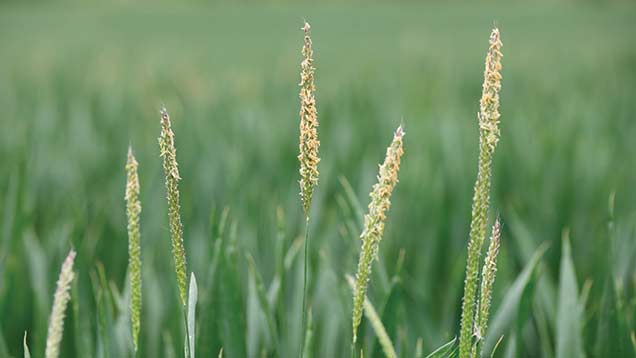Expert advice to help farmers beat blackgrass this autumn
 © Tim Scrivener
© Tim Scrivener With profit margins feeling the pinch, growers are being urged to use cultural methods of blackgrass control to stave off herbicide resistance and cut costs.
The competition from blackgrass can be staggering, with 10 plants/sq m producing 100 million seeds/ha or 80% of a 1t bag of blackgrass seed.
Sarah Cook, weed expert at Adas said widespread blackgrass resistance is here to stay and growers need to use cultural controls with the aim of getting seed populations down.
“You can never get rid of the genetic resistance in your blackgrass once you have got it, even if you were to stop using herbicides,” she told a briefing at Adas’s Boxworth site in Cambridgeshire.
See also: How to create the perfect blackgrass stale seed-bed
Reduce blackgrass populations before drilling
- Encourage weed emergence with shallow cultivations
- Spray off flushes with glyphosate
- Delay drilling until October or later if conditions allow
Barrie Hunt, Monsanto’s crop protection technical manger, added that widespread resistance to herbicides means they can’t be relied upon to tackle the problem alone, with blackgrass chemistry now only giving about 50% control in barley.
“We’ve seen a decline in chemistry with no new actives for grassweeds coming through. It is getting pretty expensive to get a very good level of control, so growers should make the most of every cultural method,” he said.
Bold action
In the past, the main focus has been on in-crop control with out-of-crop control viewed as an added bonus. Today, the two are now fundamental in blackgrass control.
BASF agronomy manager Ruth Stanley explained that growers need to implement a zero-tolerence policy to prevent seed return and view the stacking of cultural methods as the main road to control.
“We need to be controlling blackgrass with practical, cultural methods, as well as herbicide programmes,” she said.
“The message is that we need to eliminate seed return and take a zero-tolerance approach. When you look at these figures it is no wonder that wheat is struggling.”
Ms Stanley urged growers to think practically about their blackgrass situation on a field-by-field basis and make bold choices if necessary.
“Control strategies differ for each and growers need to decide which is right for their individual fields or farms, 10 blackgrass plants/ha can reduce yield by 13% and 50 plants/sq m can halve it.”
Stale seed-beds are a low-cost cultivation technique and with careful management can be an effective way of getting blackgrass to germinate rapidly in the right circumstances.
“If you are trying to get blackgrass to grow then shallow cultivation is the way forward because it is cheap and easy,” said Ms Stanley.
She recommends teaming a stale seed-bed approach with delayed drilling, pushing the drill date back into October.
Stacking
“Growers should stack non-chemical methods alongside herbicide treatments,” Ms Stanley said.
“The idea is that by the time you get round to using your post-emergence herbicides, the blackgrass will have had several hits before you get to that stage, it will be weakened and this will help with resistance issues,” she added.
Later drilling gives the stale seed-bed technique more time to give greater control by spraying off multiple flushes as they emerge, cutting the blackgrass seed numbers significantly.
Monsanto’s Mr Hunt estimated that a well-timed stale seed-bed allows control of about 50% of the potential blackgrass population.
“Excluding a stale seed-bed doubles blackgrass heads a sq m whatever the pre-em or post-em programme you have,” he said.
When it comes to delayed drilling, Adas’s Dr Cook pointed out that growers can take a logical approach by treating the worst affected blackgrass fields differently.
“Obviously delayed drilling does not need to be done in every field. There’s always one field that has to be drilled last so make it the one that’s got the worst blackgrass,” she said.
“It can be a prescriptive method of control, and put simply your choices are delayed drilling or suffering with blackgrass,” she argued.
Spring cropping is something more growers are turning to, to control bad cases of blackgrass infestation according to Ms Stanley. It’s one option she advocates for fields with populations greater than 10 plants/sq m.
“If you have got more than 10 blackgrass head/sq m you need to be brutal and not drill your next crop into that field in autumn because you are not going to make a profit,” she added.
“More people are thinking about spring cropping because so far hardly any winter seed has been sold this year. If you do opt for spring cropping make sure you are using the time well to get good flushes of blackgrass,” Ms Stanley said.
Pre-emergence herbicides
Using a pre-emergence herbicide on top of cultural controls is a staple requirement of any serious plan to tackle blackgrass.
Ms Stanley said drilling and pre-em applications need to be completed within two days of each other and recommends working through the entire process one field at a time to help with this.
“It’s vital that you use a pre-emergence herbicide. It’s an important part of your strategy because you’ve got to give your crop a chance to get up and away,” she said.
“You should be drilling and spraying with a pre-em within 48 hours – think of the two going together. Quite simply, if it is too wet to spray then don’t drill,” Ms Stanley added.
In the previous May, growers should have mapped their worst blackgrass fields and know to give them special treatment. After harvest, growers need to move from field to field working through cultivation, drilling, rolling and pre-emergence spray.
She also advised against relying on one herbicide mode of action for weed control, instead choosing actives that complement each other in a programmed approach. Flufenacet and pendimethalin should be considered the foundation for the programme.



